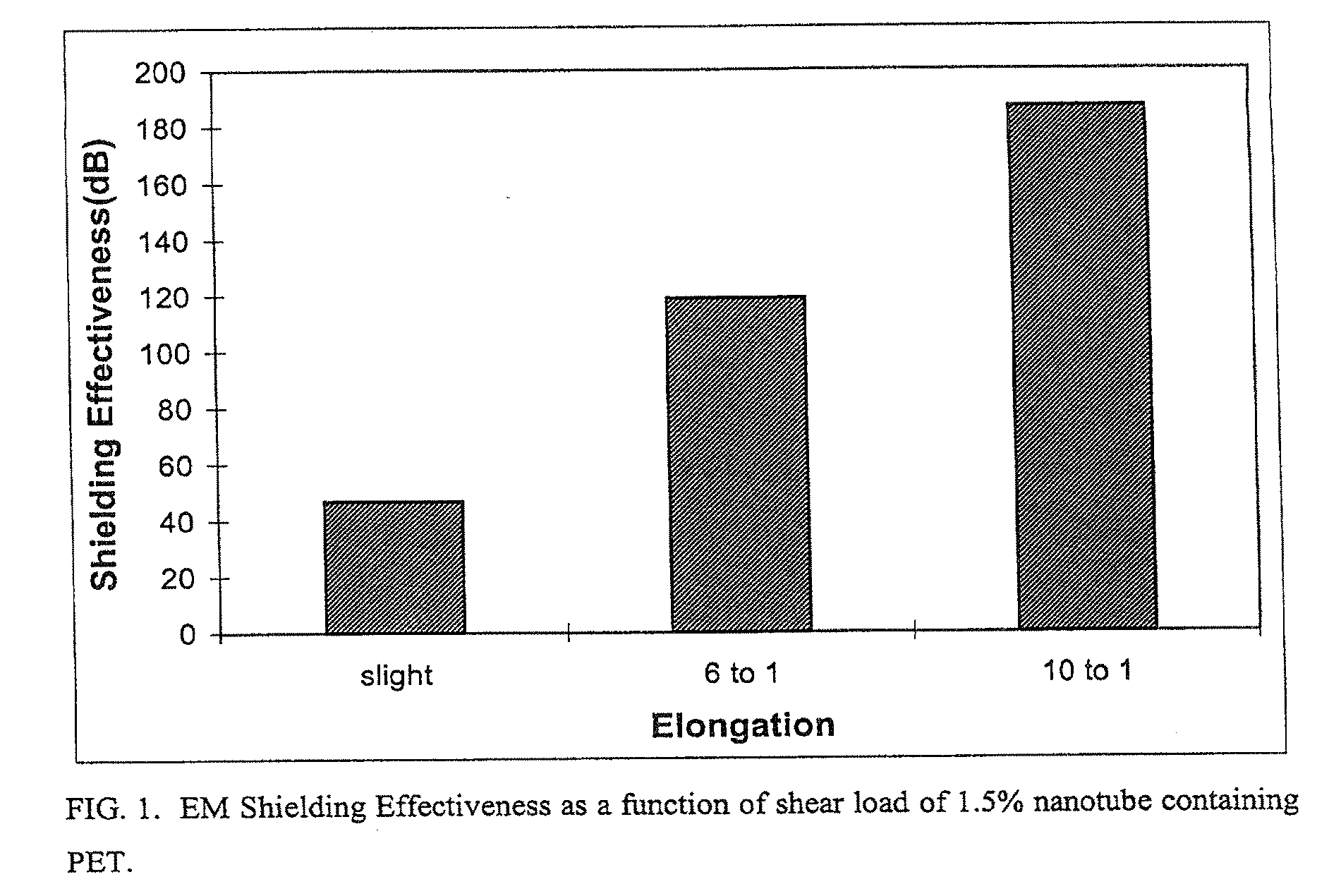Electromagnetic shielding composite comprising nanotubes
a technology of electromagnetic shielding and nanotubes, which is applied in the field of electromagnetic shielding composites containing nanotubes, can solve the problems of large need for electromagnetic shielding materials, loss of metals' inherent em shielding characteristics, and approach suffers from substantial drawbacks, and achieves the effect of low loading
- Summary
- Abstract
- Description
- Claims
- Application Information
AI Technical Summary
Benefits of technology
Problems solved by technology
Method used
Image
Examples
example 1
Electromagnetic Shielding Effectiveness (EMSE)
[0036]Five pounds of pelletized polyethylene terephthalate (PET) with fifteen weight percent Graphite Fibril™ nanotubes were produced by Hyperion Catalysis International. This Hyperion concentrate of 15 wt % carbon fibers in unspecified Eastman extrusion grade PET polyester resin was used as a master batch for let down (dilution) with neat Natural PET resin 0.85 IV Eastman natural PET. Both resins dried 4.5 hours at 290 F and kept in sealed glass bottles before use. The 1.5% carbon resin was a 9:1 blend of the concentrate and the neat resin by weight. 2:1 blends of concentrate with natural were made to reduce carbon content from 15% to 10% and again from 10% to 6.7%. In doing so, varying concentrations of nanotubes could be extruded for testing. The master batch and a letdown thereof to the plaque size required for EMI shielding testing were extruded along with a neat PET control.
[0037]A ¾ inch Brabender single screw extruder with an eng...
example 2
Dielectric Testing for Low Observability Correlation
[0052]In addition to the EMSE testing, dielectric testing to ASTM D2520 “Standard Text Test Methods for Complex Permittivity (Dielectric Constant) of Solid Electrical Insulating Materials at Microwave Frequencies and Temperatures to 1650° C.” was performed. This method uses a waveguide cavity to measure the material at microwave frequencies. The cavity measurement is the most accurate dielectric measurement available at microwave frequencies. Although cavities are designed for a discrete frequency, within the normal microwave range material dielectric properties do not change over frequency, and thus this measurement is fairly accurate for the range. This trend can be noted in the EMSE testing, where shielding effectiveness did not appreciable change over frequency sweep of 20 kHz to 1.5 GHz.
[0053]The cavity volume used was 0.960 cubic inches and the cavity (Q) equals 4308, based on ambient temperatures and typical test equipment s...
PUM
| Property | Measurement | Unit |
|---|---|---|
| frequencies | aaaaa | aaaaa |
| lengths | aaaaa | aaaaa |
| weight percent | aaaaa | aaaaa |
Abstract
Description
Claims
Application Information
 Login to View More
Login to View More - R&D
- Intellectual Property
- Life Sciences
- Materials
- Tech Scout
- Unparalleled Data Quality
- Higher Quality Content
- 60% Fewer Hallucinations
Browse by: Latest US Patents, China's latest patents, Technical Efficacy Thesaurus, Application Domain, Technology Topic, Popular Technical Reports.
© 2025 PatSnap. All rights reserved.Legal|Privacy policy|Modern Slavery Act Transparency Statement|Sitemap|About US| Contact US: help@patsnap.com

